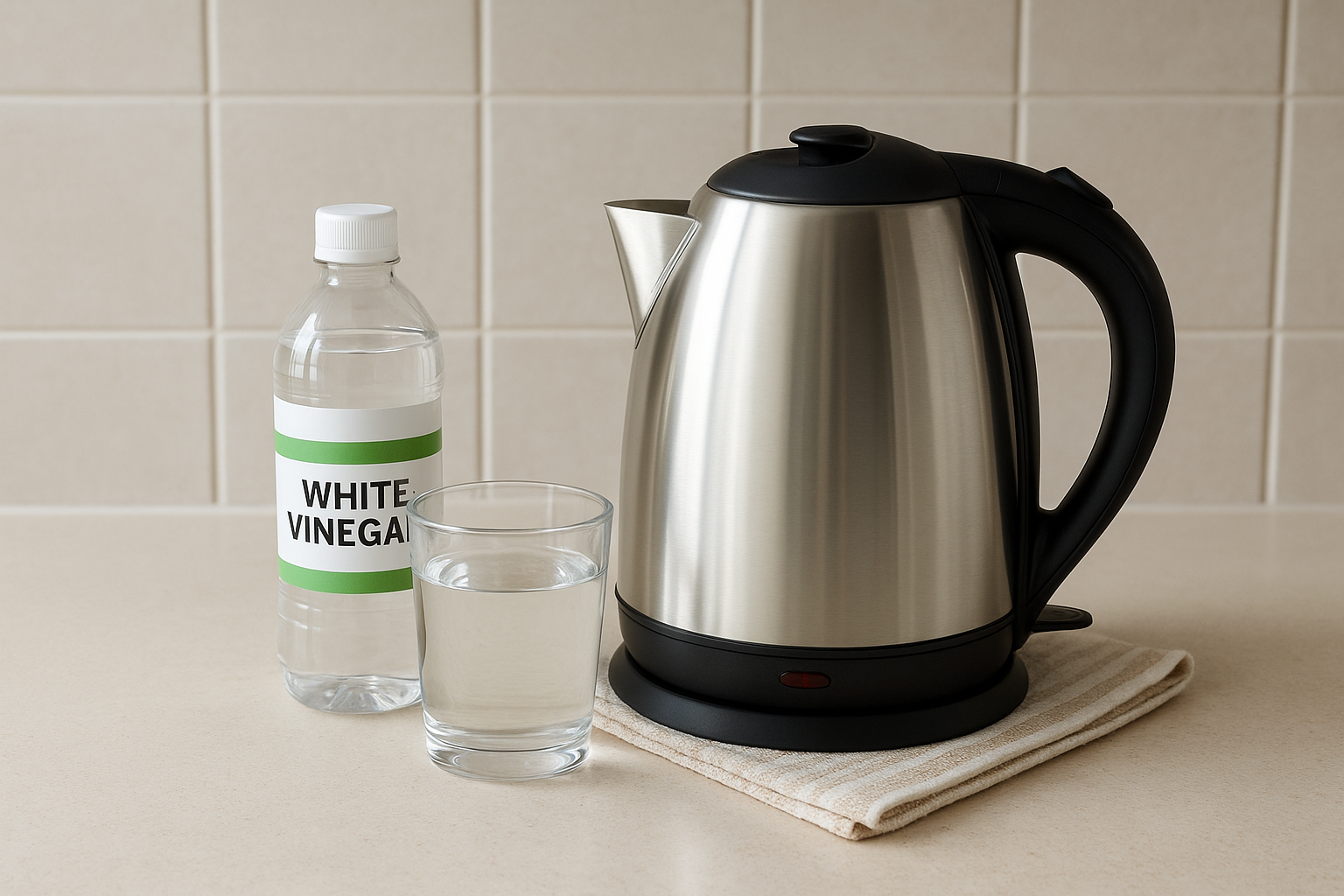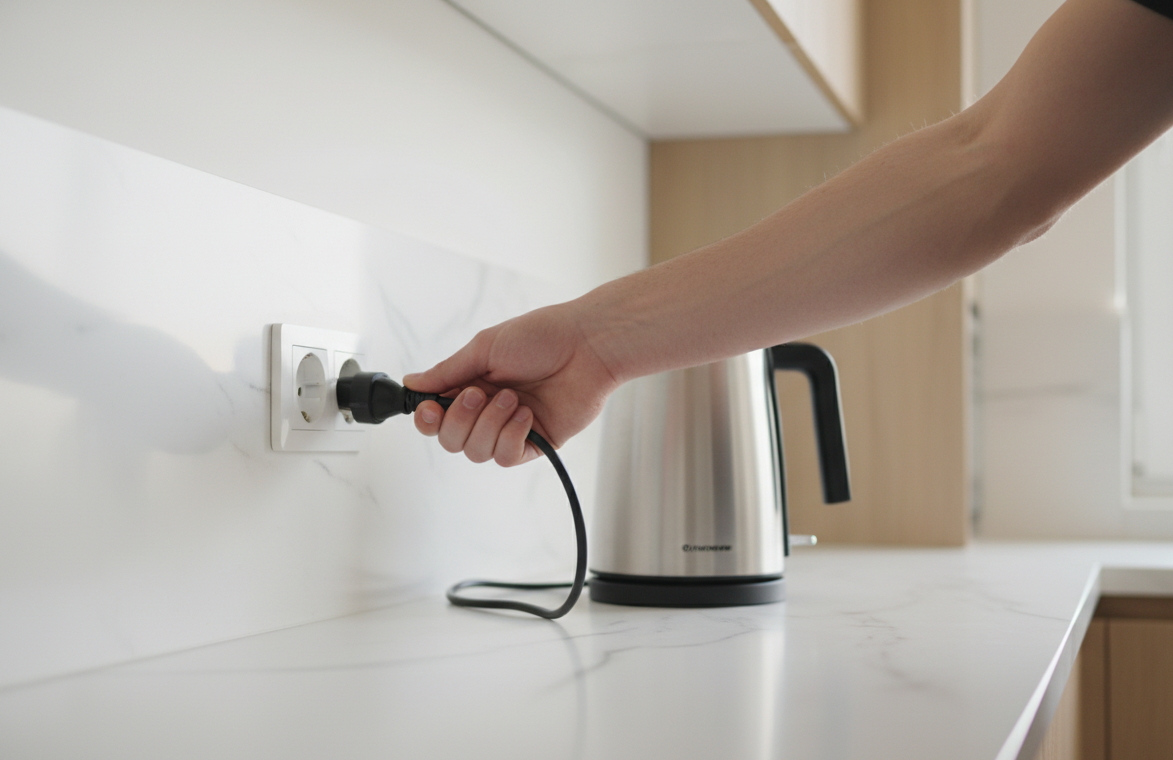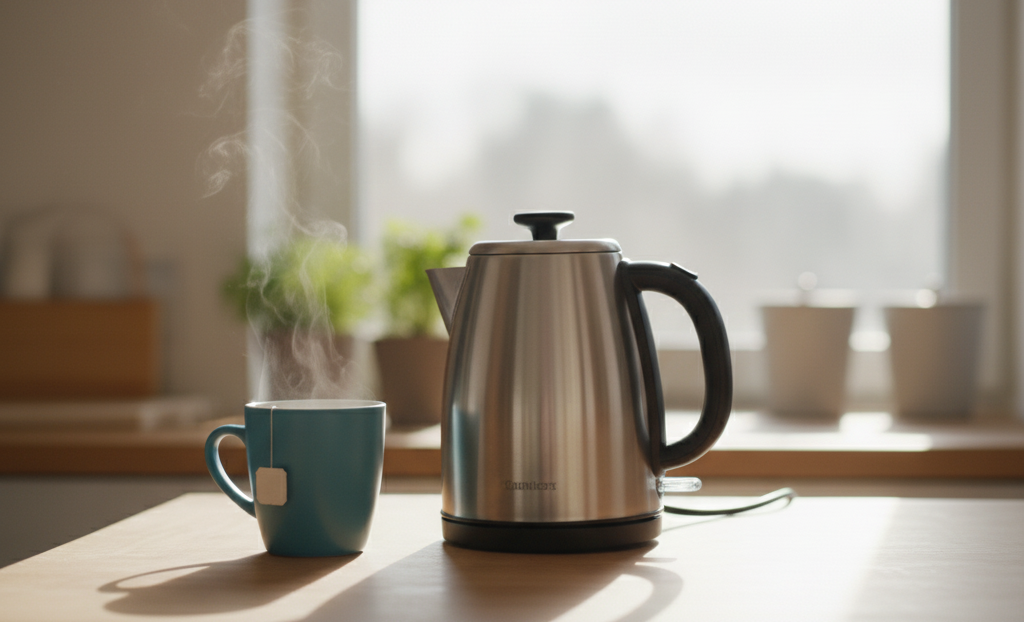Ever noticed a chalky buildup inside your electric tea kettle? That stubborn residue is likely limescale, a common issue caused by mineral deposits from hard water. Left untreated, limescale can affect the taste of your favorite tea and make your kettle less efficient.
But don’t worry, there’s a simple, natural solution right in your kitchen: vinegar. In this guide, you’ll learn how to clean an electric tea kettle using vinegar—an affordable, non-toxic cleaner that helps remove limescale, restore performance, and keep your tea tasting perfectly fresh.
Why You Should Clean Your Electric Tea Kettle?
Cleaning your kettle is about more than just a shiny appearance—it directly impacts taste, performance, and longevity. Over time, mineral deposits from hard water accumulate, slowing down the heating process, altering the flavor of your water, and potentially damaging the heating elements.
Regular cleaning helps your kettle boil water faster, improves energy efficiency, and ensures every cup of tea or coffee tastes as fresh and pure as it should. Using vinegar is a safe, natural, and affordable way to dissolve limescale and keep your kettle in top condition.
- Improved Taste: Limescale can give your hot water a bitter or metallic taste. Removing this buildup allows the true flavors of your tea to shine.
- Enhanced Efficiency: Mineral deposits interfere with the heating elements, leading to slower boil times and higher energy use. A clean kettle heats water more quickly and efficiently.
- Prolonged Lifespan: Limescale can cause long-term damage like corrosion and overheating. Regular descaling with vinegar prevents these issues, helping your kettle last longer.
Benefits of Using Vinegar to Clean Your Electric Tea Kettle
Vinegar is a simple, natural solution that effectively removes limescale buildup in electric tea kettles. This affordable, non-toxic cleaner keeps your appliance sparkling, extends its lifespan, and ensures your water tastes fresh without the need for harsh chemicals.
1. Natural and Non-toxic
Vinegar is a plant-based cleaner that’s safe for both your family and the environment. Unlike harsh chemical alternatives, it leaves no harmful residue behind. You can descale your kettle with confidence, knowing you’re using a food-safe solution.
2. Cost-Effective
Vinegar is inexpensive and widely available. A single bottle lasts for a long time, making it a smart, budget-friendly option. Why spend extra money on fancy cleaners when vinegar does the job just as well?
3. Effective Against Limescale
Limescale builds up quickly in tea kettles, affecting both taste and efficiency. Vinegar dissolves these stubborn deposits with ease. You’ll be amazed at how quickly vinegar can restore your kettle’s shine.
4. Easy To Use
Using vinegar to clean your kettle is straightforward as no special tools or complicated steps required. Just mix vinegar and water, boil, let it sit, and rinse. This hassle-free method makes routine cleaning simple for anyone, no matter how busy your schedule is.
5. Neutralizes Odors
Vinegar not only cleans but also deodorizes. It helps eliminate any strange smells from your kettle, leaving it fresh and ready for your next brew.
6. Multi-Purpose
Besides cleaning kettles, vinegar has countless household uses. From cleaning windows to freshening up laundry, keeping a bottle of vinegar around the house means you’re always ready for a natural, effective cleaning solution.
Using vinegar to clean your electric tea kettle is a smart and sustainable choice. It’s safe, affordable, and surprisingly powerful. Give it a try—you’ll notice the difference with every cup you brew.
How to Clean an Electric Tea Kettle with Vinegar
Materials You’ll Need:
- White vinegar
- Fresh water
- Soft sponge or microfiber cloth
- Lemon slices or baking soda (Optional)
Step-by-Step Cleaning Instructions
1. Unplug and Cool
Unplug the kettle and let it cool completely. Empty any remaining water and wipe the exterior with a damp cloth to remove dust or stains.
2. Mix the Vinegar Solution
Combine equal parts white vinegar and fresh water. Pour the mixture into the kettle until it’s about halfway full. This solution effectively dissolves limescale without harming the appliance.
3. Boil and Soak
Turn on the kettle and bring the vinegar solution to a boil. Once it boils, turn off the kettle and let it soak for 20–30 minutes. The combination of heat and acidity loosens stubborn mineral deposits.
4. Discard and Scrub
Carefully pour out the solution. Use a soft sponge or microfiber cloth to gently scrub away any remaining limescale. Avoid abrasive tools that could scratch the kettle.
5. Rinse Thoroughly
Fill the kettle with fresh water, bring it to a boil, then discard the water. Repeat this step once or twice to ensure all vinegar residue is removed, preventing any taste or smell from lingering.
6. Remove Lingering Odor
If a slight vinegar smell remains, fill the kettle with fresh water and add a few lemon slices or a pinch of baking soda. Boil, let it sit for 10–15 minutes, then discard and rinse again. Your kettle will smell fresh and be ready for use.
Tips for Regular Maintenance
Keeping your electric tea kettle in top shape requires more than occasional vinegar cleaning. Regular maintenance ensures it works efficiently, lasts longer, and keeps your tea tasting perfect. Here are practical tips:
Inspect Regularly: Check the kettle for rust, corrosion, or mineral buildup. Address any issues promptly to prevent bigger problems.
Keep the Exterior Clean: Wipe the outside with a damp cloth to maintain a shiny, hygienic kettle. A clean exterior also brightens your kitchen space.
Descale Monthly: Use vinegar to remove limescale and mineral deposits. Regular descaling keeps your kettle efficient and your tea tasting fresh.
Store Properly: Keep your kettle in a dry place when not in use to prevent rust or moisture damage.
Use Filtered Water: Filtered water reduces mineral buildup, protecting the heating element and improving efficiency.
Check the Cord: Inspect the electrical cord for wear or damage. Replace or repair any issues promptly to ensure safety.
Safety Precautions
Cleaning with vinegar is safe and effective, but following proper precautions protects both you and your kettle.
Unplug and Cool: Always unplug the kettle and allow it to cool completely before cleaning.
Ensure Ventilation: Use vinegar in a well-ventilated area to reduce fumes. Open windows or turn on a fan if needed.
Use the Correct Ratio: Stick to equal parts water and vinegar to avoid spills or damage to the kettle.
Handle Carefully: Pour slowly and avoid splashes to prevent irritation or accidents.
Check for Damage: Do not clean a kettle with cracks, exposed wires, or other damage.
Rinse Thoroughly: After cleaning, rinse the kettle multiple times with fresh water to remove all vinegar residue and prevent lingering taste or smell.
Alternative Cleaning Methods
While vinegar is highly effective and popular, other natural methods also work:
Baking Soda
Baking soda is a gentle cleanser. Mix it with water to form a paste. Apply the paste inside the kettle. Scrub gently with a soft brush. Rinse well to remove residue.
Lemon Juice
The citric acid in lemon juice works similarly to vinegar and it is natural. Squeeze fresh lemon juice into the kettle. Fill with water and boil. Let it sit for 30 minutes, then rinse.
Dish Soap
Mix soap with warm water and swirl the mixture around the kettle. Use a sponge to scrub inside gently, and rinse. Dish soap is safe for kettles.
Vinegar and Rice
Add a small handful of uncooked rice to a mixture of equal parts vinegar and water in the kettle. Swirl it gently—the rice acts as a natural scrub, loosening deposits without scratching the kettle. Then, pour out the mixture and rinse thoroughly.
Frequently Asked Questions
How Often Should I Clean My Electric Tea Kettle With Vinegar?
For best results, clean your electric tea kettle with vinegar every four to six weeks. If you live in an area with particularly hard water, you may need to clean it more often.
Can Vinegar Damage My Electric Tea Kettle?
No. Vinegar is a safe and effective cleaning agent for electric tea kettles as long as you use it properly. Always dilute the vinegar with water and rinse the kettle thoroughly afterward to prevent any residue from lingering.
What Type Of Vinegar Is Best For Cleaning Kettles?
White vinegar is the most recommended type for cleaning electric tea kettles. Its strong cleaning properties make it ideal for dissolving limescale and mineral deposits.
How Much Vinegar Should I Use For Cleaning?
Use equal parts white vinegar and water to fill your kettle halfway. This ratio is effective for removing limescale without being overly harsh on your appliance.
Conclusion
Cleaning your electric kettle with vinegar is simple, safe, and effective. Regular cleaning ensures better-tasting tea, improves efficiency, and extends the life of your kettle. Make it a monthly habit, rinse thoroughly, and enjoy every cup from a sparkling clean kettle.
Happy cleaning!





